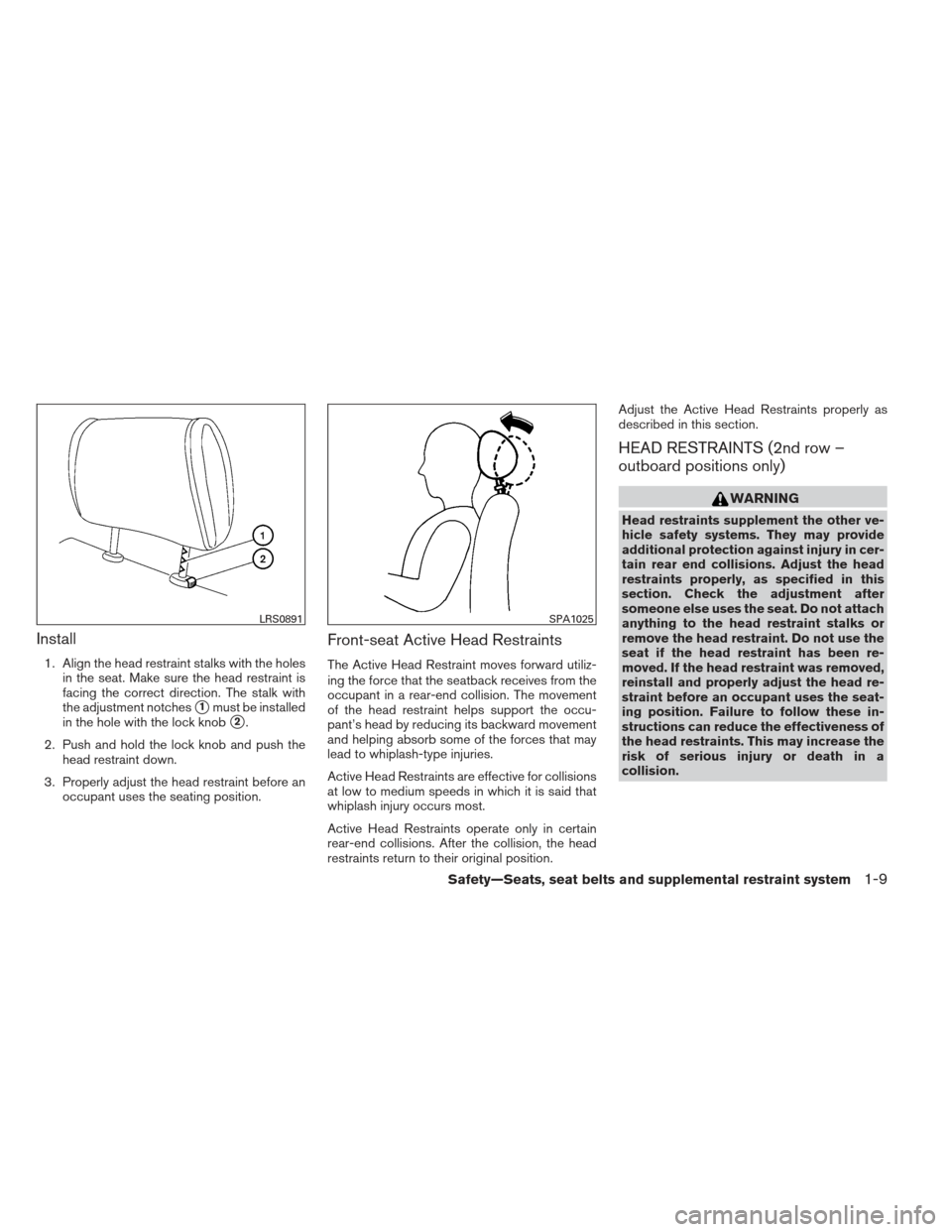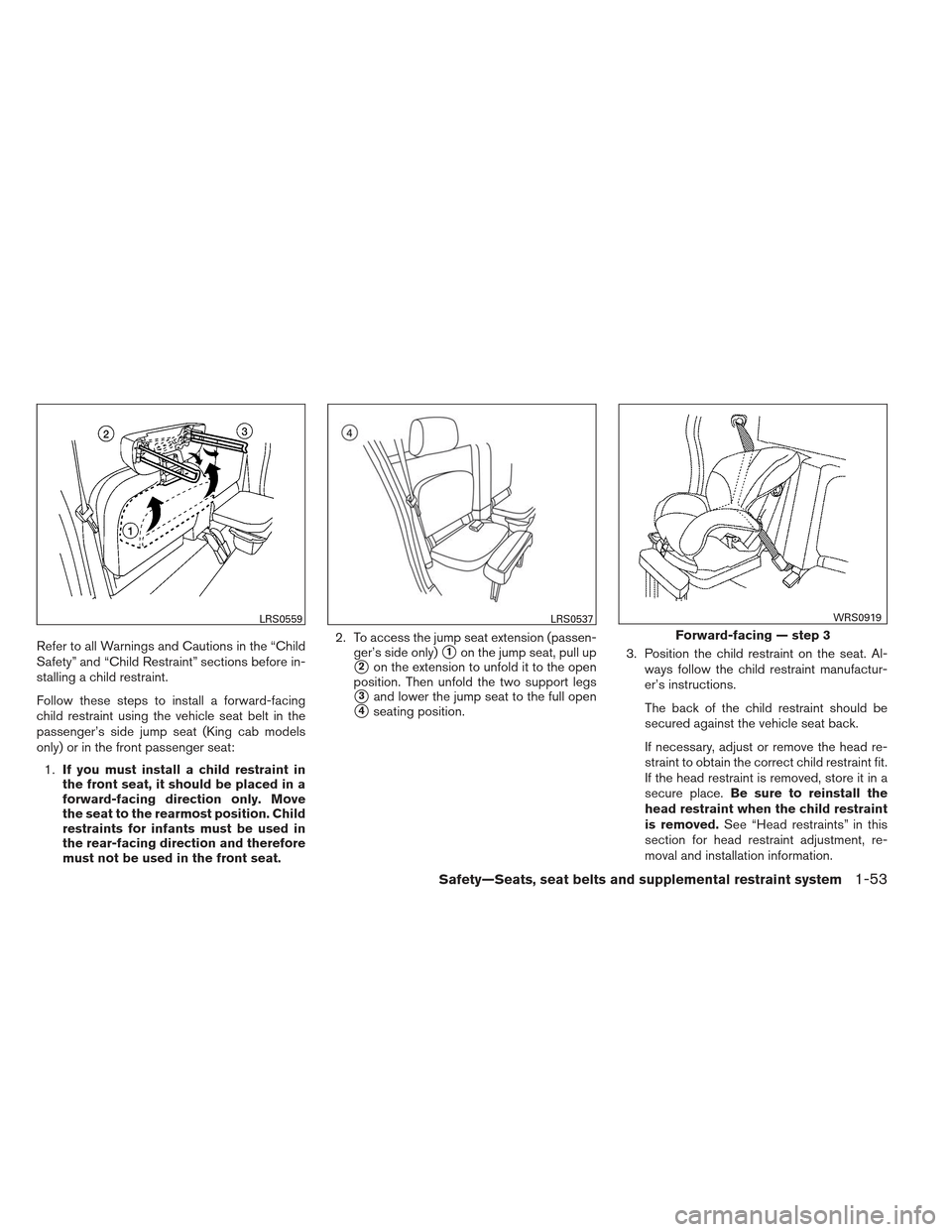Page 23 of 444
Lumbar support (if so equipped for
driver’s seat)
The lumbar support feature provides lower back
support to the driver. Move the lever forward or
backward to adjust the seat lumbar area.
FRONT POWER SEAT ADJUSTMENT
(if so equipped for Crew cab models)
Operating tips
●The power seat motor has an auto-reset
overload protection circuit. If the motor
stops during operation, wait 30 seconds,
then reactivate the switch.
● Do not operate the power seat switch for a
long period of time when the engine is off.
This will discharge the battery.
Forward and backward
Moving the switch forward or backward will slide
the seat forward or backward to the desired
position.
Reclining
Move the recline switch backward until the de-
sired angle is obtained. To bring the seatback
forward again, move the switch forward and
move your body forward. The seatback will move
forward.
WRS0389WRS0163
1-4Safety—Seats, seat belts and supplemental restraint system
Page 24 of 444
The reclining feature allows adjustment of the
seatback for occupants of different sizes for
added comfort and to help obtain proper seat
belt fit (see “Precautions on seat belt usage” later
in this section) . Also, the seatback can be re-
clined to allow occupants to rest when the ve-
hicle is stopped and the transmission is in P
(Park) or N (Neutral) position with the parking
brake fully applied.
Seat lifter (if so equipped for driver’s
seat)
Push the front or rear end of the switch up or
down to adjust the angle and height of the seat
cushion.
Lumbar support (if so equipped for
driver’s seat)
The lumbar support feature provides lower back
support to the driver. Move the lever forward or
backward to adjust the seat lumbar area.
WRS0164WRS0389
Safety—Seats, seat belts and supplemental restraint system1-5
Page 28 of 444

Install
1. Align the head restraint stalks with the holesin the seat. Make sure the head restraint is
facing the correct direction. The stalk with
the adjustment notches
�1must be installed
in the hole with the lock knob
�2.
2. Push and hold the lock knob and push the head restraint down.
3. Properly adjust the head restraint before an occupant uses the seating position.
Front-seat Active Head Restraints
The Active Head Restraint moves forward utiliz-
ing the force that the seatback receives from the
occupant in a rear-end collision. The movement
of the head restraint helps support the occu-
pant’s head by reducing its backward movement
and helping absorb some of the forces that may
lead to whiplash-type injuries.
Active Head Restraints are effective for collisions
at low to medium speeds in which it is said that
whiplash injury occurs most.
Active Head Restraints operate only in certain
rear-end collisions. After the collision, the head
restraints return to their original position. Adjust the Active Head Restraints properly as
described in this section.
HEAD RESTRAINTS (2nd row –
outboard positions only)
WARNING
Head restraints supplement the other ve-
hicle safety systems. They may provide
additional protection against injury in cer-
tain rear end collisions. Adjust the head
restraints properly, as specified in this
section. Check the adjustment after
someone else uses the seat. Do not attach
anything to the head restraint stalks or
remove the head restraint. Do not use the
seat if the head restraint has been re-
moved. If the head restraint was removed,
reinstall and properly adjust the head re-
straint before an occupant uses the seat-
ing position. Failure to follow these in-
structions can reduce the effectiveness of
the head restraints. This may increase the
risk of serious injury or death in a
collision.
LRS0891SPA1025
Safety—Seats, seat belts and supplemental restraint system1-9
Page 53 of 444

Refer to all Warnings and Cautions in the “Child
Safety” and “Child Restraint” sections before in-
stalling a child restraint.
Follow these steps to install a child restraint on
the jump seat.1. To access the jump seat extension (passen- ger’s side only)
�1on the jump seat, pull up
�2on the extension to unfold it to the open
position. Then unfold the two support legs
�3and lower the jump seat to the full open
�4seating position.
�2Move the front passenger’s seat into the
FULL FORWARD position. Then move the
front seatback to the upright or tilted forward
position. Position the child restraint on the
jump seat. The direction of the child restraint
depends on the type of the child restraint
and the size of the child. Always follow the
restraint manufacturer’s instructions.
3. Position the child restraint on the seat. Al- ways follow the child restraint manufactur-
er’s instructions.
LRS0559LRS0537
Rear-facing — step 2
LRS0544
1-34Safety—Seats, seat belts and supplemental restraint system
Page 60 of 444
Refer to all Warnings and Cautions in the “Child
Safety” and “Child Restraint” sections before in-
stalling a child restraint.
Follow these steps to install a child restraint on
the passenger’s side jump seat.1. To access the jump seat extension
�1on the
passenger’s side jump seat, pull up
�2on
the extension to unfold it to the open posi-
tion. Then unfold the two support legs
�3
and lower the jump seat to the full open�4
seating position.
�2Move the front passenger’s seat into the
FULL FORWARD position. Then move the
front seatback to the upright or tilted forward
position. Position the child restraint on the
jump seat. The direction of the child restraint
depends on the type of the child restraint
and the size of the child. Always follow the
restraint manufacturer’s instructions.
LRS0559LRS0537
Rear-facing — step 2
LRS0544
Safety—Seats, seat belts and supplemental restraint system1-41
Page 65 of 444
– For forward-facing child seats andboosters, DO NOT install if the child
restraint base extends past the for-
ward edge of the driver’s side seat
cushion.
Refer to all Warnings and Cautions in the “Child
Safety” and “Child Restraint” sections before in-
stalling a child restraint.
Follow these steps to install a child restraint on
the jump seat.1. To access the jump seat extension (passen- ger’s side only)
�1on the jump seat, pull up
�2on the extension to unfold it to the open
position. Then unfold the two support legs
�3and lower the jump seat to the full open
�4seating position.
WRS0699LRS0559
1-46Safety—Seats, seat belts and supplemental restraint system
Page 72 of 444

Refer to all Warnings and Cautions in the “Child
Safety” and “Child Restraint” sections before in-
stalling a child restraint.
Follow these steps to install a forward-facing
child restraint using the vehicle seat belt in the
passenger’s side jump seat (King cab models
only) or in the front passenger seat:1. If you must install a child restraint in
the front seat, it should be placed in a
forward-facing direction only. Move
the seat to the rearmost position. Child
restraints for infants must be used in
the rear-facing direction and therefore
must not be used in the front seat. 2. To access the jump seat extension (passen-
ger’s side only)�1on the jump seat, pull up
�2on the extension to unfold it to the open
position. Then unfold the two support legs
�3and lower the jump seat to the full open
�4seating position. 3. Position the child restraint on the seat. Al-
ways follow the child restraint manufactur-
er’s instructions.
The back of the child restraint should be
secured against the vehicle seat back.
If necessary, adjust or remove the head re-
straint to obtain the correct child restraint fit.
If the head restraint is removed, store it in a
secure place. Be sure to reinstall the
head restraint when the child restraint
is removed. See “Head restraints” in this
section for head restraint adjustment, re-
moval and installation information.
LRS0559LRS0537
Forward-facing — step 3
WRS0919
Safety—Seats, seat belts and supplemental restraint system1-53
Page 79 of 444

●Make sure the child’s head will be properly
supported by the booster seat or vehicle
seat. The seatback must be at or above the
center of the child’s ears. For example, if a
low back booster seat
�1is chosen, the
vehicle seatback must be at or above the
center of the child’s ears. If the seatback is
lower than the center of the child’s ears, a
high back booster seat
�2should be used.
● If the booster seat is compatible with your
vehicle, place the child in the booster seat
and check the various adjustments to be
sure the booster seat is compatible with the
child. Always follow all recommended pro-
cedures.
All U.S. states and Canadian provinces or
territories require that infants and small
children be restrained in an approved child
restraint at all times while the vehicle is
being operated.
The instructions in this section apply to booster
seat installation in the rear seats or the front
passenger seat.
Booster seat installation on front
passenger seat and rear seat (Crew
cab models only)
CAUTION
Do not use the lap/shoulder belt in the
Automatic Locking Retractor mode when
using a booster seat with the seat belts.
Refer to all Warnings and Cautions in the “Child
Safety”, “Child Restraint” and “Booster Seats”
sections before installing a child restraint.
Follow these steps to install a booster seat in the
rear seat or in the front passenger seat: 1.If you must install a booster seat in the
front seat, move the seat to the rear-
most position.
2. Position the booster seat on the seat. Only place it in a front-facing direction. Always
follow the booster seat manufacturer’s in-
structions.
WRS0699
1-60Safety—Seats, seat belts and supplemental restraint system